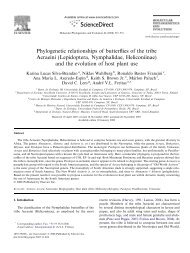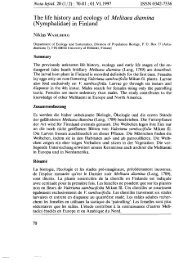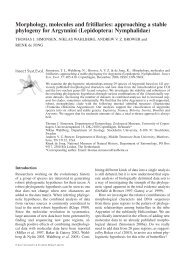Varying rates of diversification in the genus Melitaea (Lepidoptera ...
Varying rates of diversification in the genus Melitaea (Lepidoptera ...
Varying rates of diversification in the genus Melitaea (Lepidoptera ...
You also want an ePaper? Increase the reach of your titles
YUMPU automatically turns print PDFs into web optimized ePapers that Google loves.
VARYING RATE OF SPECIATION IN MELITAEA 355<br />
with M. consulis and M. coll<strong>in</strong>a shar<strong>in</strong>g a most recent<br />
common ancestor with <strong>the</strong> rest <strong>of</strong> <strong>the</strong> group that lived<br />
dur<strong>in</strong>g <strong>the</strong> late Burdigalian (Fig. 3). This common<br />
ancestor is estimated to have been widespread <strong>in</strong> <strong>the</strong><br />
Palaearctic, whereas <strong>the</strong> most recent ancestor <strong>of</strong> <strong>the</strong><br />
coll<strong>in</strong>a group was exclusively liv<strong>in</strong>g <strong>in</strong> <strong>the</strong> Western<br />
Palaearctic. Ano<strong>the</strong>r long branch leads to M. ardu<strong>in</strong>na<br />
and M. av<strong>in</strong>ovi, whose l<strong>in</strong>eage is estimated to<br />
have diverged from <strong>the</strong> rest <strong>of</strong> <strong>the</strong> phoebe group <strong>in</strong> <strong>the</strong><br />
early Langhian ma<strong>in</strong>ly <strong>in</strong> <strong>the</strong> Central Palaearctic.<br />
The rest <strong>of</strong> <strong>the</strong> species belong<strong>in</strong>g to <strong>the</strong> phoebe group<br />
show a variable pattern <strong>of</strong> distribution, with <strong>the</strong><br />
ancestral distributions be<strong>in</strong>g <strong>in</strong>ferred as relatively<br />
widespread. Interest<strong>in</strong>gly, <strong>the</strong> divergences <strong>of</strong> M.<br />
phoebe, M. sib<strong>in</strong>a, and M. scotosia are <strong>in</strong>ferred to be<br />
more recent (Pleistocene) than <strong>the</strong> divergence <strong>of</strong> M.<br />
punica (Pliocene), which is <strong>of</strong>ten considered a subspecies<br />
<strong>of</strong> M. phoebe.<br />
The fergana group is estimated to orig<strong>in</strong>ate <strong>in</strong> <strong>the</strong><br />
Central Palaearctic dur<strong>in</strong>g <strong>the</strong> Langhian with a phylogeographical<br />
pattern very similar to <strong>the</strong> arcesia<br />
group <strong>in</strong> <strong>the</strong> <strong>Melitaea</strong> clade. It is also characterized by<br />
species that are restricted to mounta<strong>in</strong> zone <strong>in</strong> <strong>the</strong><br />
Central Palaearctic. It diverged from its sister group<br />
(<strong>the</strong> didyma group) approximately 15 Mya dur<strong>in</strong>g <strong>the</strong><br />
ma<strong>in</strong> uplift <strong>of</strong> <strong>the</strong> Himalaya.<br />
As described previously, our analyses highlight <strong>the</strong><br />
complexity <strong>in</strong> <strong>the</strong> pattern <strong>of</strong> relationship between <strong>the</strong><br />
different populations <strong>of</strong> M. didyma; for example, one<br />
<strong>in</strong>dividual sampled <strong>in</strong> Sou<strong>the</strong>rn France is closely<br />
related, with a time to most recent common ancestor<br />
(tmrca) close to 2 Mya, to <strong>the</strong> <strong>in</strong>dividual <strong>of</strong> M. latonigena<br />
(sometimes regarded as a subspecies <strong>of</strong> M.<br />
didyma) caught <strong>in</strong> <strong>the</strong> Eastern Siberian mounta<strong>in</strong>s.<br />
The populations <strong>the</strong>y belong to are toge<strong>the</strong>r sister to<br />
<strong>the</strong> North African population <strong>of</strong> M. didyma (estimated<br />
tmrca 5 Mya). The same pattern <strong>of</strong> genetic divergence<br />
has also been identified between <strong>the</strong> two <strong>in</strong>dividuals<br />
<strong>of</strong> M. deserticola that have been <strong>in</strong>cluded. They have<br />
been sampled <strong>in</strong> Syria (zone <strong>in</strong>corporated <strong>in</strong> <strong>the</strong><br />
Western Palaearctic) and North Africa and <strong>the</strong>ir<br />
tmrca is by <strong>the</strong> analysis estimated to be close to <strong>the</strong><br />
latter (i.e. <strong>the</strong> dry<strong>in</strong>g out <strong>of</strong> <strong>the</strong> Mediterranean Sea).<br />
Our results also <strong>in</strong>dicate that M. n<strong>in</strong>ae (also known as<br />
M. pseudoala) was long ago genetically isolated from<br />
M. ala, apparently more closely related to M. didyma.<br />
VARIATION IN THE RATE OF SPECIATION<br />
THROUGH TIME<br />
As shown above, it appears that <strong>the</strong> events <strong>of</strong> speciation<br />
are not randomly distributed <strong>in</strong> time. In <strong>the</strong> very<br />
first part <strong>of</strong> <strong>the</strong> curve, we notice that <strong>the</strong> rhythm <strong>of</strong><br />
speciation starts relatively high and decreases<br />
slightly after two million years. This ‘push <strong>of</strong> <strong>the</strong> past’<br />
is likely to be an artefact result<strong>in</strong>g from <strong>the</strong> fact that<br />
we are consider<strong>in</strong>g those clades that survived to <strong>the</strong><br />
present day, and <strong>the</strong>se are <strong>the</strong> ones that, on average,<br />
got <strong>of</strong>f to a fly<strong>in</strong>g start (Nee et al., 1994). A second<br />
change <strong>in</strong> <strong>the</strong> rhythm <strong>of</strong> speciation is estimated to<br />
have occurred dur<strong>in</strong>g <strong>the</strong> Langhian, contemporary<br />
with <strong>the</strong> ma<strong>in</strong> Tibetan Plateau uplift (Coleman &<br />
Hodges, 1995). This is <strong>the</strong> time when <strong>the</strong> arcesia and<br />
fergana groups, which comprise exclusively butterflies<br />
found <strong>in</strong> <strong>the</strong> mounta<strong>in</strong> ranges associated with<br />
<strong>the</strong> Tibetan Plateau uplift, orig<strong>in</strong>ated. Subsequently<br />
<strong>the</strong> speciation rate rema<strong>in</strong>ed slower and stable for<br />
approximately 4 Mya. The next turn is situated<br />
dur<strong>in</strong>g <strong>the</strong> early Tortonian and, subsequently, ano<strong>the</strong>r<br />
one takes place <strong>in</strong> <strong>the</strong> middle Tortonian at a time<br />
when it is believed that <strong>the</strong> climate globally cooled<br />
down, <strong>the</strong> ice sheet appeared <strong>in</strong> Antarctica as well as<br />
<strong>the</strong> monsoon <strong>in</strong> Asia (Zachos et al., 2001). Several<br />
turns are visible on <strong>the</strong> curve dur<strong>in</strong>g <strong>the</strong> Mess<strong>in</strong>ian:<br />
<strong>the</strong> rhythm <strong>of</strong> speciation <strong>in</strong>crease by pulse and<br />
rema<strong>in</strong>s high until <strong>the</strong> end <strong>of</strong> <strong>the</strong> Age. The Mess<strong>in</strong>ian<br />
is well known for <strong>the</strong> dramatic climatic and geomorphological<br />
changes that occurred beg<strong>in</strong>n<strong>in</strong>g<br />
with open<strong>in</strong>g <strong>of</strong> terrestrial communication between<br />
Eurasia and North Africa. The Mediterranean Sea<br />
dried up completely dur<strong>in</strong>g 5.6 and 5.3 Mya, after<br />
which <strong>the</strong> Straits <strong>of</strong> Gibraltar reopened and has<br />
rema<strong>in</strong>ed open until present (see below). Our analysis<br />
shows that, out <strong>of</strong> <strong>the</strong> five events <strong>of</strong> divergence<br />
between Africa and Eurasia, four could have taken<br />
place dur<strong>in</strong>g <strong>the</strong> relatively brief Mess<strong>in</strong>ian period.<br />
The curve rema<strong>in</strong>s more flat for <strong>the</strong> last 5 million<br />
years, although unsampled species (which are likely<br />
to be closely related to sampled species, see Material<br />
and methods) mean that <strong>the</strong> <strong>rates</strong> <strong>of</strong> speciation are<br />
underestimated at <strong>the</strong> tips <strong>of</strong> <strong>the</strong> tree.<br />
DISCUSSION<br />
ABOUT THE METHODOLOGY<br />
Interpretations, subjectively made from <strong>the</strong> results,<br />
are based on <strong>the</strong> reliability <strong>of</strong> <strong>the</strong> <strong>in</strong>ferences, which<br />
are objectively constructed from non-exhaustive data<br />
by algorithms. The reliability <strong>of</strong> <strong>the</strong> <strong>in</strong>ferences made<br />
can be assessed by <strong>the</strong> <strong>in</strong>dices <strong>of</strong> confidence given by<br />
<strong>the</strong> analyses. When estimat<strong>in</strong>g <strong>the</strong> phylogenetic relationships<br />
<strong>of</strong> organisms, <strong>the</strong>se <strong>in</strong>dices are represented<br />
by node support (e.g. bootstrap values for parsimony<br />
analysis and posterior probabilities for Bayesian<br />
<strong>in</strong>ferences). In <strong>the</strong> present study, <strong>the</strong> topology <strong>of</strong> <strong>the</strong><br />
parsimony and Bayesian based <strong>in</strong>ferences are very<br />
similar, but <strong>the</strong> average support <strong>of</strong> <strong>the</strong> nodes appears<br />
to be stronger <strong>in</strong> <strong>the</strong> latter, although <strong>the</strong> comparability<br />
<strong>of</strong> <strong>the</strong> two different forms <strong>of</strong> support has been <strong>the</strong><br />
subject <strong>of</strong> debate (Douady et al., 2003). The bootstrap<br />
values can be used to evaluate <strong>the</strong> relative amount <strong>of</strong><br />
© 2009 The L<strong>in</strong>nean Society <strong>of</strong> London, Biological Journal <strong>of</strong> <strong>the</strong> L<strong>in</strong>nean Society, 2009, 97, 346–361





